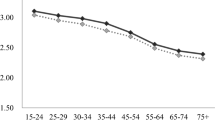Abstract
In order to explore the complex mechanisms of married women’s decisions in matters of childbirth, we studied empirically the relations between family size and aspects of lifestyle through a questionnaire survey administered in 2006 to married women living in the city of Suita, Japan, a suburb of Osaka. Lifestyle was taken as a complex of mutual relationships among individual (biographical, psychological) and social (socioeconomic, social support) factors, and our aim was to clarify differences in Japan in lifestyle among married women based on the number of their children. Analysis of 495 respondents showed mothers with only a single child were more self-reliant: they tend to give birth at a late age, enjoy cooperation with their husbands in family finances, be psychologically at ease, and not seek help from others in child rearing. Mothers with three or more children embody more of the traditional role for Japanese women: they tend to give birth at an early age, be reliant on their husbands financially, be less at ease psychologically, and seek others’ help in child rearing. These differences suggest that more focus on psychological, not just economic support in government policy to counteract declining fertility is an important issue for future consideration.
Similar content being viewed by others
References
Ministry of Health, Labour and Welfare: Outlook on 2010 FY fertility–related statistics: Special report on population vital statistics. Retrieved from http://www.mhlw.go.jp/toukei/saikin/hw/jinkou/tokusyu/syussyo06/dl/01.pdf, 10 April 2012 (in Japanese)
National Institute of Population and Social Security Research: Japan’s estimated future population (December 2006 estimate). Retrieved from http://www.ipss.go.jp/ppnewest/j/newest03/newest03.pdf, 10 April 2012 (in Japanese)
McDonald P.: Very low fertility: Consequences, causes and policy approaches. The Japanese Journal of Population. 6, 19–23 (2008)
Otani Y.: Countermeasures to Japan’s declining birthrate and the policy environment. Japan Medical Association Journal. 53, 8–13 (2010)
Iwasawa M.: On the contribution of the changes in first marriage behavior and couples’ reproductive behavior to the recent change in total fertility rates of Japan. Journal of Population Problems. 58(3), 15–44 (2002) (in Japanese)
Kaneko R., Sasai T., Kamano S., Iwasawa M., Mita F., Moriizumi R.: Marriage process and fertility of Japanese married couples: Overview of the results of the Thirteenth Japanese National Fertility Survey, Married Couples. The Japanese Journal of Population. 6, 24–50 (2008)
Noguchi H.: Do work–life balance measures and workplace flexibility matter?: An empirical analysis for female reinstatement choice after the first childbirth. The Japanese Journal of Social Security Policy. 8, 1–19 (2009)
Tomari S., Yoshida F.: The relationship between affect, use of place, and the functions of private space. Japanese Journal of Social Psychology. 15, 77–89 (1999) (in Japanese)
Warren S., Brandeis L.: The right to privacy. The Harvard Law Review. 4, 193–220 (1890)
Westin A.: Privacy and freedom. Atheneum, New York (1967)
Altman I.: The environment and social behavior. Brooks/Cole, California (1975)
Tomari, S., Yoshida, F.: A private time/space scale. Yoshida, F.: Grasping the links between people and society: Values and relations with others, volume 2 of Anthology of psychological measurement scales. Tokyo: Saiensu–sha, 427–435, 2001 (in Japanese)
Testa, M.: Childbearing preferences and family issues in Europe. Retrieved from http://ec.europa.eu/public_opinion/archives/ebs/ebs253en.pdf, 10 April 2012
Statistical Research and Training Institute: Japan statistical yearbook 2012. Tokyo: Statistics Bureau, Ministry of Internal Affairs and Communications, 2012
Matsumoto, S., Cao, Y.: Kindergarten as a meeting place for mothers. Thompson, S.: Kindergartens: Programs, functions and outcomes. New York: Nova Science Publishers, 163–177, 2010
Cao Y., Matsumoto S., Murata T.: Factors promoting childbearing among married women: On the prioritization of socio–economic and psychological factors. RISS Discussion Paper Series. 12, 1–13 (2011)
Okamoto Y.: A comparative study on the sense of identity and child–rearing between Japanese and Chinese women in adulthood. Journal of Home Economics of Japan. 53, 193–198 (2002) (in Japanese)
Nishita Y.: Diverse life–styles and psychological well–being in adult women. Japanese Journal of Educational Psychology. 48, 433–443 (2000) (in Japanese)
Kojima H.: Third childbirth factors. Journal of Health and Welfare Statistics. 42(2), 9–14 (1995) (in Japanese)
Sasai T.: A study on regional differentials in marital fertility. Journal of Population Problems. 63(3), 14–27 (2007) (in Japanese)
Author information
Authors and Affiliations
Corresponding author
Rights and permissions
About this article
Cite this article
Cao, Y., Matsumoto, S. & Murata, T. Married Women’s Lifestyles in Japan: Disparities Based on the Number of Children. Rev Socionetwork Strat 6, 1–14 (2012). https://doi.org/10.1007/s12626-011-0023-4
Received:
Accepted:
Published:
Issue Date:
DOI: https://doi.org/10.1007/s12626-011-0023-4




